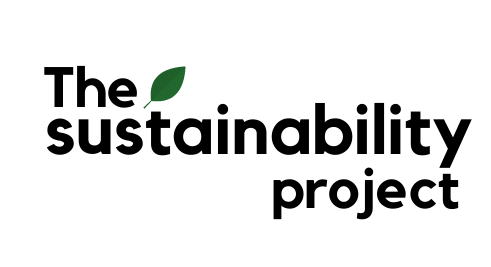In the last part of Shopping For Sustainability Series, we discuss some ways in which companies market their goods so appealing that will encourage mindless consumption, and how this may affect the way a customer chooses what to buy in the supermarket!
Because marketing is so prevalent in supermarkets where consumers are free to make many choices, three very different product types are discussed in this post!
Excessive Snack Packaging
Perhaps you may have seen Rice Media’s recent article about unnecessarily exorbitant mooncake packaging. Well, we don’t have to wait till Mooncake Festival to bring up the problems behind excessive packaging of our foods, and snacks in particular.
Did you know that of the 1.6 million tonnes of domestic waste disposed of in 2018 in Singapore, one-third is made up of packaging?
Currently, about 50% of discarded packaging is food packaging. While it is good to note that not all food packaging is bad – a cling-wrapped cucumber can last for 14 days as compared to a few days without wrapping – much of this waste may have resulted from misunderstood consumer demand.
In Daniel Imhoff’s book titled Paper or Plastic, he argues that excessive packaging results from a misunderstanding of consumer demand for increased levels of packaging.
Because flashy designs are more appealing to the customer first instead of a plain jane design, companies tend to adopt these types of elaborate packaging in order to get more people to purchase their products.
However, it’s what’s inside that counts! And what you actually use or consume is rather independent of the type of box that you place the product in! Excessive packaging therefore often ends up as waste, or stuffed into an obscure corner of your house, never to be touched again.
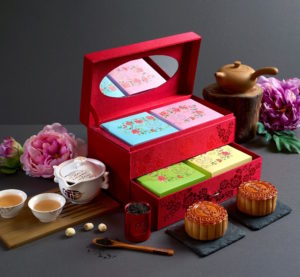
How many of these boxes can you actually repurpose? Throwing them away may seem like such a waste of all the effort and raw material that has gone into making them. Source: Shang Social
Categories For Packagings
On top of that, another form of excessive packaging is the use of secondary packaging. Using the example of snacks, the packaging they come in can be categorized into three types:
| Primary Packaging | Secondary Packaging | Tertiary Packaging |
| Contains only the product itself | Contains the primary packaging (e.g. smaller bags of chip that come in a huge bag, or 3-in-1 coffee satchets that come in a pack) | Boxes used for bulk handling and warehouse storage of products |
Most snacks use all three packaging, especially those that are packed into smaller bags.
Secondary packaging is seen by some as rather unnecessary, since it is usually discarded immediately when consumers use the product.
It’s definitely more convenient, and consumers often choose these over a large packet because opening a large packet of chips would get soggy fast in Singapore’s humid climate.
The Problem With Snack Packaging
Lastly, snack packaging is mostly made of metallized films (plastics containing a thin layer of aluminum metal).
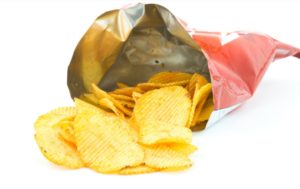
Metalised packaging! Source: https://www.thermofisher.com/blog/food/inspecting-snack-foods-through-metalized-film-packaging/
Although the individual components of metallized films are technically recyclable, the difficulty in sorting and separating them economically feasible recycling.
Therefore, snack packaging is largely unrecyclable because of the lamination inside the bags. Another type of relatively unsustainable material used to make snack packaging is Polyvinylidene chloride (PVdC), which contains high amounts of chlorine. And therefore also presents problems with incineration.
It’s probably clear by now how packaging contributes so highly to waste issues. Is it then possible to avoid packaging in urban supermarkets? You may consider buying snacks and other dried goods from bulk produce shops like The Source, Scoops, Reprovisions or Unpackt!
For products with shorter lifespans and therefore unavailable for purchase at bulk shops, reject those with elaborate or secondary packaging!
What about when you have cravings for crispy snacks? Well, secondary packaging can be used to line your bins or used as a small trash bin.
On the supplier’s side, some suppliers such as Milo has actually reduced their packaging sizes to reduce the amount of raw material used; for instance Milo powder packages have reduced in size without reducing its content over the years, and this has saved 30 tonnes of plastic laminate material each year!
It’s also great to know that some supermarkets overseas such as Tesco are aiming to ban brands that use excessive packaging, though we have yet to see that in Singapore.
There have also been efforts by local supermarket chains to work with suppliers to reduce packaging used when transporting and retailing these products.
Reducing Packaging Waste
Lastly, you can also choose to support the Singapore’s Packaging Agreement! This is a joint initiative by the Singapore government, industry and non-governmental organisations to reduce packaging waste.
As a voluntary opt-in agreement, the SPA provides flexibility for the industry to adopt cost-effective solutions to reduce waste.
Marketing gimmicks in bottled water
It is very likely to find minimally four or five different brands of bottled water on an average supermarket shelf. However, what would make you choose one brand over another?
Different companies employ interesting marketing techniques in order to brand their bottle differently from competitors.
But in reality, bottled water may not necessarily be “better” or have more health benefits. And it is often just purified municipal water and lacks essential minerals — brands like Dasani and Aquafina are cleaned-up city water.
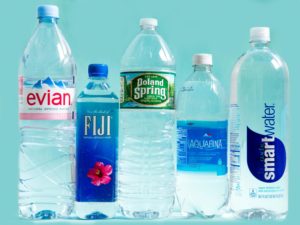
Source: https://www.seriouseats.com/2017/07/how-bottled-water-became-americas-most-popular-beverage.html
There are a few other fancy schmancy words that you may come across. “Alkaline” water is water that is said to neutralize acids in our bodies. It slows down the aging process and even prevent diseases like cancer. No wonder ionizers have become so popular nowadays
But there is no conclusive research to prove that alkaline water is really better for our health. There are also no proven benefits to “oxygenated” water, or adding oxygen to water.
How about “artesian” water? It’s not necessarily better or healthier, and contains the standard contaminants found in most well water, despite being naturally filtered.
Reducing Plastic Bottles
How then would one get water when you’re out? In actual fact, Singapore’s tap water is actually free of hard metals, and safe enough to drink!
If you are concerned about hygiene of water ducts and pipes, they are maintained regularly to ensure water is clean. Public Utility Board (PUB) also ensures our local water supply is transported via cement-lined ductile iron and steel water mains!
And they comply with international standards! There is no need to worry about tap water quality.
As such, bottled water is rather unnecessary in Singapore, and we could probably all do without this supermarket good.
I would understand if one finds it strange to take water straight from the tap initially, and so you can encourage the installation of drinking water fountains within your own communities, and discourage public sector entities and schools from serving bottled water (some organisations such as MBS have stopped serving bottled water!).
Lastly, try to avoid drinking bottled water even if you are served it!
Electronics – Planned Obsolescence
Some larger hypermarkets in Singapore actually do sell electronics, which brings about the issue of planned obsolescence. This phenomenon is when a product is deliberately designed to have a specific life span, usually a shortened life span.
This gives businesses the opportunity to innovate more models and variations of products with updates on “improvements”. And these appealing new releases of electronics lure the customer into repeated unnecessary consumption that generates large amounts of e-waste.
As a result, e-waste has turned into a prolific problem, with an estimated 50 million tons of e-waste generated globally every year, at an estimated loss of $5 billion dollars in the landfills.
In smartphones, for example, it is possible that software updates are a form of planned obsolescence! Just last year, Apple and Samsung, were fined for knowingly implementing operating system updates that reduced performance significantly and accelerated consumers’ substitution for a new phone.
These dishonest commercial practices force the production of supposedly better smartphones, with rather insignificant differences. Eventually, wasting resources we didn’t even need to utilise in the first place.
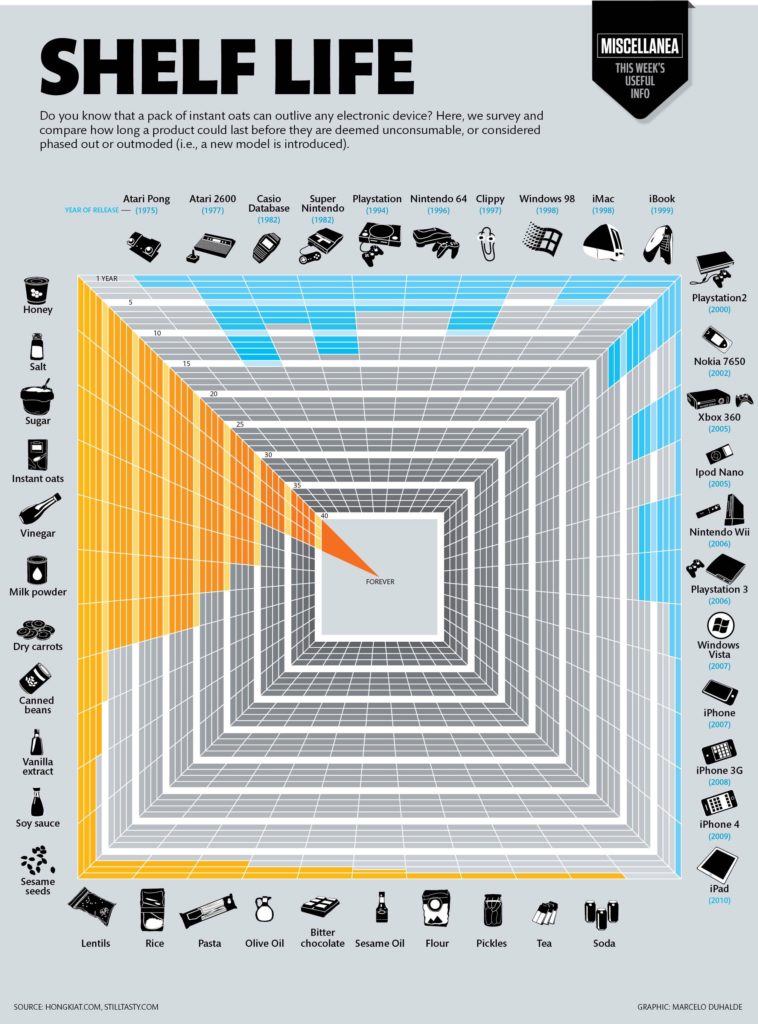
In this interesting graphic, a comparison is made between food items and electronics, in terms of the amount of times it takes for each item to be unconsumable or phased out.
In Singapore, the increased consumption of electronics contribute to the already massive amount of e-waste Singapore produces, especially if we are unable to manage and recycle them properly.
Reducing Our Electronic Waste
As a consumer, it’s important to practice the 5Rs (Refuse, Reduce, Reuse, Repurpose, Recycle) before purchasing electronics to help reduce our chances of mindlessly buying new electronics!
If possible, try to opt for products with longer warranty period and longer shelf life, or purchase electronics second-hand!
We can make a change by providing feedback to electronic companies to innovate products with longer shelf life. Ultimately with green consumerism, such companies would often consider customer’s inputs when designing their products.
With this article, we conclude the 3-part series of Shopping For Sustainability! We have explored various sustainability issues we face in the supermarket as consumers!
And we hope that we have provided you with tips on reducing your environmental impact as a conscious supermarket shopper!
